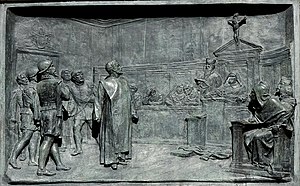Giordano Bruno
Giordano Bruno (January 1548 – 17 February 1600) was an Italian friar of the Dominican Order. He was also a philosopher and mathematician. He is best known for believing in the infinity of the universe. His cosmological theories went beyond the Copernican model.
Giordano Bruno | |
|---|---|
 Modern portrait based on a woodcut from "Livre du recteur", 1578 | |
| Born | Filippo Bruno January 1548 |
| Died | 17 February 1600 (aged 52) Rome, Papal States |
| Cause of death | Execution by burning |
| Era | Renaissance philosophy |
| Region | Western philosophy |
| School | Renaissance humanism Neoplatonism Neopythagoreanism |
Main interests | Philosophy, cosmology, and mathematics |
Notable ideas | Cosmic pluralism |
Influences | |

Bruno thought the Sun was just one of an infinite number of independently moving heavenly bodies. He is the first man to have thought the stars we see at night are identical in nature to the Sun. For publishing beliefs contrary to Roman Catholic dogma about transubstantiation, trinity and other matters, he was burnt at the stake as a heretic by the Inquisition of the Roman Catholic Church.
Bruno also wrote extensive works on the art of memory, a loosely organized group of mnemonic techniques and principles.[3]
The charges
changeThe Catholic Church made the following accusations against Bruno:[4]
- Holding opinions contrary to the Catholic Faith and speaking against it and its ministers.
- Holding wrong opinions about the Trinity, about Christ's divinity and Incarnation.
- Holding wrong opinions about Christ.
- Holding wrong opinions about Transubstantiation and Mass.
- Claiming the existence of a plurality of worlds and their eternity.
- Believing in the transmigration of the human soul into brutes.
- Dealing in magics and divination.
- Denying the Virginity of Mary.
Bruno did accept and promote Copernicus' idea that the Earth revolves round the Sun. Many believe this was one of main reasons for his downfall; others think his theological beliefs were more critical.[5] In 1584 he published two dialogues which argued for his idea on astronomy.[6] Eight years later he was arrested, and his trial took another eight years. His accusers demanded complete recantation of all his 'erroneous' beliefs. He refused, and went to his death. Later the Inquisition used his example to terrify Galileo into withdrawing his works from publication.
Related pages
changeReferences
change- ↑ Leo Catana (2005). The Concept of Contraction in Giordano Bruno's Philosophy. Ashgate Pub. ISBN 978-0754652618.
When Bruno states in De la causa that matter provides the extension of particulars, he follows Averroes.
- ↑ Bouvet, Molière; avec une notice sur le théâtre au XVIIe siècle, une biographie chronologique de Molière, une étude générale de son oeuvre, une analyse méthodique du "Malade", des notes, des questions par Alphonse (1973). Le malade imaginaire; L'amour médecin. Paris: Bordas. p. 23. ISBN 978-2-04-006776-2.
{{cite book}}: CS1 maint: multiple names: authors list (link) - ↑ Yates, Frances A. 1966. The art of memory.
- ↑ Firpo, Luigi 1993. Il processo di Giordano Bruno.
- ↑ Yates, Frances A. 1964. Giordano Bruno and the hermetic tradition. Chicago.
- ↑ De la Causa, Principio, et Uno (1584) Full Italian text, Giordano Bruno.info: Download Archived 2011-07-21 at the Wayback Machine; De l'infinito Universo et Mondi (1584) Full Italian text, Giordano Bruno.info: Download Archived 2011-07-21 at the Wayback Machine;